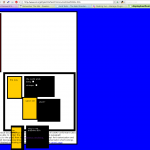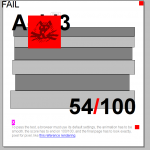Firefox regression?
While going through my feeds today, I happened to land up on the [[http://acidtests.org|ACID tests]] web page, and so I thought “hmm, let me see how Firefox does”. My expectation was that since Firefox is touted to be such a standards compliant browser, it’d pass tests 1 and 2 with flying colors. I already know that it doesn’t pass Acid3 yet, so I wasn’t expecting much anyways.
And so I was quite shocked to see it miserably fail both [[http://acid1.acidtests.org|Acid1]] and [[http://acid2.acidtests.org|Acid2]]. I’m not sure if this is because some extension that I have (unlikely). I’m running Firefox 2.0.0.13 on Ubuntu Gutsy (7.10). Take a look at the results of the test:
A more extensible KDE
First off, I love KDE and I am a long time KDE user. I use GNOME/GTK applications where they good KDE/QT based alternatives don’t exist, but I prefer K-land in general. Don’t get me wrong, KDE is one of most extensible free desktops out there. However, I do think it is missing extensibility in a few key areas, namely the web browser (Konqueror) and groupware (the KDE PIM suite).
The explosive adoption and popularity of Firefox is a testament to the power of having an extensible platform. The ingenuity was in opening up the API and then getting out the way of developers. Even a cursory look at the [[https://addons.mozilla.org/en-US/firefox/|extensions directory]] shows that big and small developers basically just ran with the extension mechanism, using it to enhance the user experience of Firefox in often unexpected ways. And thats the real beauty of the system — it is now self-sustained, with a vibrant, thriving and supporting community. Another huge facilitator was a centralized extension directory and a built-in auto update mechanism.
{{ http://www.mozilla.org/products/firefox/buttons/header.png|Mozilla Firefox}}
A similar phenomenon has propelled the growth of Thunderbird. While the [[https://addons.mozilla.org/en-US/thunderbird/|Thunderbird extension directory]] is not nearly as comprehensive as the Firefox one, there is nevertheless a lot of interest and enthusiasm in extending Thunderbird. It also allows users to take advantage of newly enabled functionality without waiting for a proper release to come out. For instance, there is a [[https://addons.mozilla.org/en-US/thunderbird/addon/4631|provider for Googel Calendar]] which allows read/write access to your Google Calendar from within the Thunderbird UI (using Sunbird or Lightning). Or check out [[http://simile.mit.edu/seek/|Seek]], which builds a completely new search interface (Faceted Browsing) in Thunderbird.
On the other hand, despite having an [[http://ubuntuforums.org/showthread.php?t=418950|excellent]] [[http://vntutor.blogspot.com/2008/02/10-hidden-features-of-konqueror.html|feature]] [[http://www.konqueror.org/features/|set]] and a proven rendering engine (KHTML, from which WebKit was derived, which in turn powers Safari, among others) [[http://konqueror.kde.org|Konqueror]] never quite hit mainstream. Even today its user base is limited to power browsers or loyal KDE fans. I have myself [[http://floatingsun.net/2005/10/10/konqueror|tried to switch to Konqueror full time]] but always gave up, usually because of lack of functionality compared to Firefox (often enabled due to various plugins I had installed) and bad support for advanced Javascript and most noticeably, Flash.
Konqueror implemented support for Netscape/Firefox plugins as a stop gap measure, but AFAIK that mechanism was primarily meant for Flash, and even then it is quite flaky (it //still// doesn’t work for me). There never was the ability to use any of the regular XPI/XUL based Firefox addons.
{{ http://www.kde.org/stuff/clipart/klogo-official-oxygen-128×128.png|KDE}}
Similarly crippled is the entire groupware suite in KDE, [[http://kontact.kde.org|Kontact]] and all its component applications, most notably [[http://kontact.kde.org/kmail/|KMail]] and [[http://kontact.kde.org/korganizer/|KOrganizer]]. Here are just few of the ways in which I would **love** to extend KMail and KOrganizer, but have no way of doing so, short of downloading the code, making the changes and compiling from source, which makes it all but impossible for the vast majority of users out there:
* allow KAddressBook to synchronize with my Google Contacts
* allow KOrganizer to synchronize with and edit my Google Calendar
* support for arbitrary tags/labels in KMail
* build an attachment browser for KMail
* build email analysis and visualization into KMail
It might be that some of these are better implemented as core features and not as plugins, but thats not the point. What frustrates me is that there is //no// way for me to easily and quickly extend the functionality of my applications, despite the fact that KDE has always had a really clean and modular architecture, so building a plugin mechanism really shouldn’t have been that hard. Case in point: Amarok.
Anywho, with KDE4 and the consequent KDEPIM port/rewrite, we have a chance to fix things. Please, //please// make sure that an extensible plugin based architecture is a first class feature this time. And with the [[http://kross.dipe.org/|Kross]] framework, I should be able to write extensions in several popular languages (btw, I’m not a big fan of XUL/XPI, and the documentation on them is not that great either). It would be so much easier and nicer to be able to write addons in Python or Ruby.
So here’s to a more extensible KDE.
Filelight alternatives for Windows
I was recently running Windows on my dual-boot laptop and realized that I was all but out of disk space. Now, granted that this is not a particularly monstrous partition, but I was still surprised that the 30 gigs was so close to exhaustion despite that the fact that I don’t have a lot of media (music, videos) or that many heavy applications (perhaps the biggest is Office).
[[http://www.methylblue.com/filelight/images/filelight-1.0.png|{{ http://www.methylblue.com/filelight/images/filelight-1.0.png?200x200}}]]
Faced with similar situation in Linux, I would immediately fire up [[http://www.methylblue.com/filelight/|Filelight]], an excellent utility that “creates an interactive map of concentric, segmented rings that help visualise disk usage on your computer.” So I went looking around for similar alternatives for Windows.
In the Windows world, it seems that [[wp>Treemap]]s are more popular than radial representation. I did find [[http://treepieblog.blogspot.com/|treepie]] but it wasn’t all that exciting. I then chanced upon [[http://windirstat.info/|WinDirStat]] and [[http://w3.win.tue.nl/nl/onderzoek/onderzoek_informatica/visualization/sequoiaview//|SequoiaView]].
[[http://floatingsun.net/wordpress/wp-content/uploads/2008/03/sequoiaview_-_c-03272008-063441pm.jpg|{{ http://floatingsun.net/wordpress/wp-content/uploads/2008/03/sequoiaview_-_c-03272008-063441pm.thumbnail.jpg}}]]
[[http://floatingsun.net/wordpress/wp-content/uploads/2008/03/c_-_windirstat-03272008-063434pm.jpg|{{ http://floatingsun.net/wordpress/wp-content/uploads/2008/03/c_-_windirstat-03272008-063434pm.thumbnail.jpg}}]]
Both the tools are extremely similar in functionality (and even visuals). SequoiaView seems to be an effort out of the University of Technology at Eindhoven (Netherlands). WinDirStat is almost a direct port (in features and user interface) of [[http://kdirstat.sourceforge.net/|KDirStat]]. In my limited testing, I found SequoiaView to be faster than WinDirStat, but WinDirStat had a better experience overall.
Thanks to these tools, I was quickly able to locate and eliminate the bloat.
Looking glass: search keywords
I’ve been meaning to post some analysis data on the traffic that drives my site for a while now but never get around to it. This is first in a series of posts which looks at what people have been reading on my site, what works and what doesn’t. This data has been gleaned from [[http://analytics.google.com|Google Analytics]] with the following caveats:
* there was no monitoring for most of 2005–2006
* there is no data for at least half of 2006–2007
So really the only solid data set is from 2007–2008. Nevertheless, some data is better than no data so I’m looking at it anyways. Finally, I will also try to correlate this with the top keywords as reported by WordPress Stats and AWStats to see how well they match. Without further ado, here are the top ten searched keywords for the past three years:
^ Rank ^ 2005–2006 ^ 2006–2007 ^ 2007–2008 ^
| 1 | procastrination | airtel call home | quickstar |
| 2 | quickstart amway | airtel callhome | bww |
| 3 | apahran | airtel india call | airtel call home |
| 4 | riya | airtel call india | wordpress widgets |
| 5 | udai | amazon ec2 | __macosx |
| 6 | dell linux irda 8600 | wordpress widgets | reservation in higher education |
| 7 | fluxiom | udai | airtel india call |
| 8 | “web2.0 office”, | mapmyindia | udai |
| 9 | amway quickstart | mit sketching | airtel call india |
| 10 | cryptography | latex beamer | web based password manager |
Clearly [[http://floatingsun.net/2006/12/18/more-on-airtel-call-home/|my]] [[http://floatingsun.net/2006/12/18/airtel-call-home/|posts]] on Airtel’s [[http://airtelcallhome.com|Call Home]] service stole the show in 2006–2007. It remains a strong contender the next year as well. However, in 2007, almost everything else was completely drowned out by my [[http://floatingsun.net/2005/05/06/quickstartamwaybww/|Quixstar/BWW post]]. What I’m not showing here, however, is by //how much// do the ranks differ. Suffice to say that the number of hits on the Quixstar post far outnumbered the number of hits on everything else put together pretty much.
There don’t seem to be any surprises here either. I’m not sure if I should feel good or bad about it. The hope is that by taking stock of these keywords, I can get a better sense of exactly what is it that people come to this site for. Not that I’m writing for an “audience” per se, but there’s no harm in writing what people actually like to read :-) As I said before, I’ll try to follow up with some more stats soon.


